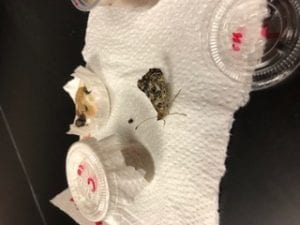 Title: Balancing Act
Title: Balancing Act
Media: Paper, hot glue
Size: 11in x 11.5 in x 10.5 in (length x width x height)
Reflection: “What challenges did you face in completing the assignment? How did you address/troubleshoot them?”
As a group, we faced several challenges in the process of completing this assignment. Making all the fans in order to assemble our structure was simple. Putting them together, and getting them to stay together proved to be a much more difficult task. We tried several approaches. The first approach was just to hook the ends of the fans onto one another. That structure collapsed the moment we set it down on the table. The next approach was regular glue. That didn’t work very well either. We actually ended up tearing a few fans in the process, and it was very lucky that we had extra fans to use as backup. Even then, we had to hold the fans together at the center and pray that they would stay stuck there on their own. They did not. This one collapsed just as easily as the first, although, this attempt made much more of a mess. The table got a bit sticky. Nevertheless, we prevailed. Finally, we found something that worked. Hot glue. After gluing all the fans together in the center of the structure, the hot glue dried quickly. And it stayed. Our structure never fell apart again. It was also much more sturdy than our previous attempts at the structure. We did face issues along the way of making this structure, but the result was well worth the trials we faced.
—
 Title: Dragonfly
Title: Dragonfly
Media: Wire
Size: 11in x 16.25in x 2.5in (length x width x height)
Reflection: “In what ways have you improved as a writer/artist/scientist/etc.? What brought about those improvements?”
Even though it doesn’t look all that fancy, I do believe I have improved as an artist in the creation of this dragonfly. Before this year, the only three-dimensional art I had personally worked with included clay sculptures and origami. I was never one for building three dimensional objects, because they always turned out looking wonky. That’s not to say that the dragonfly isn’t wonky– I do admit that it has its imperfections. Prior to this project specifically, I had never worked with wire to create something. It seemed a lot more simple as an idea than it actually turned out to be. Bending wire is difficult when you only have your hands to work with, especially since I challenged myself not to have to use hot glue. That’s part of the reason why the structure of the dragonfly is so eccentric. The dragonfly is made up of different coils of wire that all interlock with one another, which is evident by all the random-seeming loops and coils. The structure needed to be able to stand on its own, without glue or other support. So it did. Now, it’s most certainly not the most beautiful dragonfly. It’s asymmetric and even a little bland. Our wire insects were meant to imitate natural insects. Nature is not a perfect thing. Nature is filled with things that are symmetric. Nature is filled with things that are bland. Yet, we love these uneven, boring things as they are. In the same way, the messy, simplistic style of this wire dragonfly can be appreciated. It was a first attempt at something I had never done before as an artist, and I do believe it’s pretty good for a first try.
—
 Title: Cardboard Sushi
Title: Cardboard Sushi
Media: Cardboard, hot glue
Size: 1in x 1in x 1in (length x width x height)
Note: This was a group assignment. My two sushi are the third one from the left in each row.
Reflection: “What went according to plan and what surprises did you encounter?”
Most of the process of making the life-sized cardboard sushi went according to plan. All of the ones that were made solely from cardboard and smaller bits of cardboard were simple. They were structures that could be completed in a few minutes, if given your complete attention. My first sushi, the one without the explosion of hot glue dots on top, went exactly according to plan. I built the outside structure of the sushi from thin, textured pieces of cardboard. Then, I filled a hole in the center with thin, rolled-up sheets of cardboard in order to represent the thinly sliced ingredients that would go in the center of an actual sushi roll. For my second sushi, though, I wanted to do something a little more outside of the box. I wanted to do something that no one else in the group had done. So, I attempted to mimic the kind of sushi that are topped with fish eggs. What surprise did I encounter? Well, I didn’t so much encounter it. I handed it directly to myself. Hey, let’s change our plan last minute to make something cool! Nothing could go wrong with that, right? Well, not at first. At first, it seemed like a simple enough idea. How hard could it be to make a tower of glue dots? Evidently, it was much more difficult than I thought. The process was almost painstakingly slow. I could only apply one or two glue dots at a time, and they had to be at opposite sides of the sushi, otherwise they’d melt together and form an incoherent blob. This became increasingly difficult as the tower grew. If one inch by one inch of space was too small, then a tower that pointed inwards like a pyramid was going to be impossible to deal with. It took a lot of time and patience that I honestly didn’t think I was going to find within myself, but eventually, I had accomplished my vision. A fish egg sushi.
—
 Title: Discontentment
Title: Discontentment
Media: Foam board, paint, hot glue
Size: 8in x 8 in x 0.5in (length x width x height)
Reflection: “Describe the aims and strategies that led to the completion of this artifact.”
My aim in this project was a little complex. I wanted to create something that has no definite look to it. To explain, I find myself listening to podcasts rather frequently. In one, the villain is described as taking on the colors of a black opal. If you’ve never seen one, it’s a deep black with splashes of red, green, yellow, and blue. That’s what the colors I chose were meant to emulate. At times, the villain is also described as possessing far too many eyes. Bright white with colorful irises. So, I attempted to recreate this. I painted the surface on the very bottom in random patterns of red, green, yellow, and blue. It does look extremely disorganized, yes, but that’s how it’s meant to be. It mimics the random, nonsensical patterns that can be seen in a mineral found in nature. Then, I used hot glue to add on strips of black foam board, towering over the rest of the structure. I did this for two purposes. The first was that I didn’t want to simply paint black over all the colors on the bottom. It would look far too tacky, and it wouldn’t catch your eye at all. One of the interesting things about the manner in which I built this structure was how at each angle you look at it, you get a slightly different image. It shifts. The second purpose for the strips of black foam board was that the assignment instructions required our structure to extend outwards from the wall, so I made mine do just that. Then, I glued on the eyes that the villain is described as possessing. Overall, the project does look a bit messy from first glance. That’s the point, though. You don’t think of a villain and see something pristine and polished. You see something that’s a little rough around the edges, something that is evidently imperfect. The piece is titled Discontentment. I did this for a reason as well. The heroes of the show often referred to the villain as “The Hunger”. When the villain learned of this, he remarked that the term didn’t quite fit. This entity, this being was not hungry. It was discontent. It was looking for something far greater than what the simple bounds of humanity could offer it. So, the villain pointed out that a much more fitting term for the entity would be “Discontentment”. That is why I named the piece as such. It is made to represent the villainous entity that has no definitive look, since it is an audio-only medium. I do believe that I did well on this project. It looks very similar to how I had originally pictured it to look, except originally, I had wanted to make it bigger. I then decided that with the time restrictions we had, a larger piece would be too ambitious. Instead, I ambitiously added as much as I could to this smaller piece in order to make it a clear representation.
—

Title: Petrified
Media: book, tissue paper, printer paper, sharpies, markers, glue, ziploc bag, colored pencil
Size (when closed like a normal book): 5.5in x 9in x 1in (length x width x height)
Size (when posed “open” like in the image): 5.5in x 9in x 5.5in (length x width x height)
Reflection: “What challenges did you face in completing the assignment? How did you address/troubleshoot them?”
The challenges I faced when creating this project were the sheer amount of time it took and how to make it look as neat as possible. So, on the point of making it look neat, no work of art looks perfect. There’s always going to be some flaws. My goal with this project, however, was to have as few flaws as possible, because I had my heart set on a certain look for the final product, and I knew that would never quite be achieved if I wasn’t precise. That leads to the second point, the sheer amount of time it took. As a combination of both the amount of work and types of work that had to be done, I spent several of our 85-minute and 35-minute class periods working on this, and even still, I had to bring the project home over winter break to add some finishing touches and other details. Cutting out rectangles in every page was one of the most tedious jobs, because I had to make sure I had the same rectangle cut out of every single one of the 400+ pages in this book. The next tedious job I had to accomplish was gluing together all of the pages. In my head it seemed a lot more simple to do than it actually was. I remember distinctly a handful of days over our winter break where I sat down and glued pages together for hours at a time. It took even longer because for a while, I was dead set on having all the pages being perfectly lined up, like a real book. Some of them are a little out of line or bent up, but I still managed to achieve a mostly lined-up set of pages in the final product. I spent time sketching, outlining, and coloring the robot and the crystals in the project. I spent time trying to figure out how to begin to attach the ziploc bag to the project, to establish the fact that the robot is trapped. This project took a lot of time both in and outside of class, which was a very big challenge for me. In the end, though, all the work paid off. You can see my process with this altered book by clicking on this link.
—
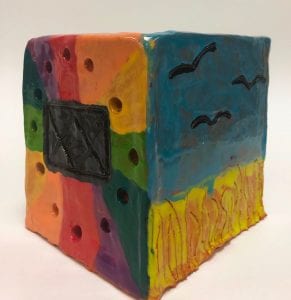
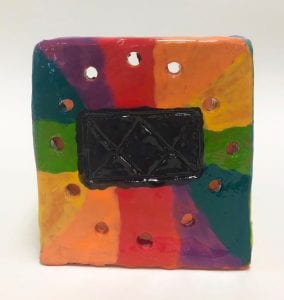
Title: Balance
Media: clay, glaze
Size: 5in x 5in x 5in (length x width x height)
Reflection: “In what ways have you improved as a writer/artist/scientist/etc.? What brought about those improvements?”
In doing this project, I feel like I have improved as an artist. In my lifetime, I never worked much with clay aside from small-scale art projects in elementary school. I was never the best at working with clay, either. Most of my clay projects from elementary school turned out lopsided and generally sloppy. So, starting this project I was a little scared, because I’m well aware that I’m not very talented when it comes to working with clay. I didn’t want to get a bad grade just because I couldn’t make something that looked nice. So, I worked as hard as I could. I put my heart into this project, and I worked on it to the very best of my ability. In the end, this was the result. It actually looks pretty nice, even if it is a little rough around the edges. It’s not perfect, but it was the best I could do. Considering it actually looks like a lantern and functions as one, I consider it a huge success. I even managed to earn a good grade on the assignment. Considering all of this, I am very proud of what I accomplished.
—
Final Reflection Prompts and Responses:
Prompt One: “What was your biggest accomplishment in the course? How did this artifact and other course elements help you reach it? Be specific.”
My biggest accomplishment in this course was definitely the candle votive, or the clay lantern. I haven’t worked with clay very much in my lifetime, and even still, I have never been especially talented at working with clay. This project was a very big project, and we spent the better part of a month’s worth of classes working on it. The sculpture isn’t perfect. It’s messy and it definitely could have been better if we had had more time to work on it. But, I put everything I had into this project, and even though it’s not the best, I’m still proud of the result. It’s not perfect, but it’s the best I could do. This project was a big accomplishment for me because it isn’t something I’m especially familiar with, and despite being messy, the result is still very good. The project earned a 48/50, which I was kind of surprised by at the time. Looking back on it, though, I definitely earned that grade. I worked hard, and I made something that was worthy of an A. In doing this project, I learned a lot about clay that I never really knew before, and I learned how to work with it properly. With all the things I learned, I was able to create the final product. That’s why the clay lantern was my biggest accomplishment in this class, because it’s a grade I really feel like I earned.
Prompt Two: “Discuss your best work for the course and explain why it’s your best. Be specific.”
My best work from the course was probably the altered book sculpture. This project looks much better than I ever expected it to. I had a plan for how it would look from the beginning, but I never would have guessed that it’d turn out the way it did. I spent a lot of time in class and at home working on the book. I spent much of the time in class cutting out the pages from the book, which took a lot more time than I expected it to. If I’m remembering correctly, it took me about three 85-minute class periods to finish cutting out the rectangles in 400+ pages. To be fair, though, I had to ensure that all the rectangles were the same size and lined up properly. Even still, you have to be very precise when cutting the pages so that it doesn’t look sloppy. Like I mentioned before, I did a lot of work on this project in-class, but I also brought it home over winter break to make sure I could add some finishing touches, and the project would be the best it could be. I spent time drawing out the robot that’s glued between some of the pages, I spent time outlining and coloring the robot, I spent time drawing all the crystals that can be seen in the project, and I spent time outlining and coloring those, too. I spent time getting the tissue paper to look nice and flat, and also to get the tissue paper to fit the book. I spent time drawing and outlining crystals on tissue paper for the ones on the “ground” of the scene. I spent a lot of time gluing all 400+ pages together. I can’t remember how many glue sticks I went through, but it was around ten glue sticks and a lot of my time. Gluing the pages together was a tedious process, because it looks messy if everything isn’t lined up properly. Even then, the sheer volume of the pages made it a lot of work. The point is, I spent very much time making this project look good, and it shows. That’s why the altered book is my best work from the course.

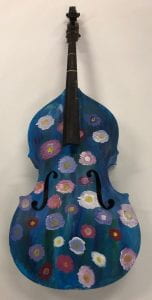
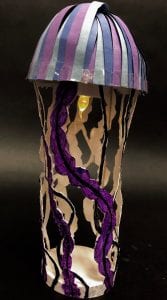
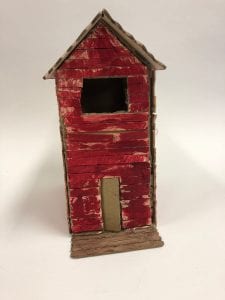
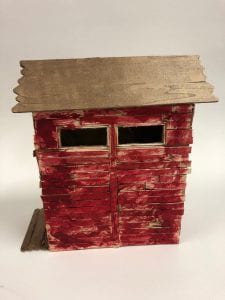


 Title: Balancing Act
Title: Balancing Act Title: Dragonfly
Title: Dragonfly Title: Cardboard Sushi
Title: Cardboard Sushi Title: Discontentment
Title: Discontentment


